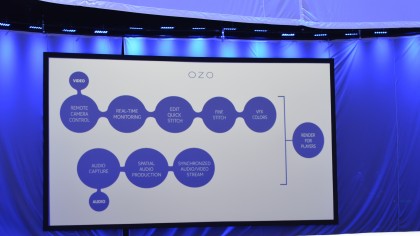What Nokia's $60,000 virtual reality camera means for you
It's not a camera for the average person, but the content will be

The specs of the device include stereoscopic 3D video through eight synchronized global shutter sensors (which are 2K x 2K resolution per eye) and spatial audio through eight integrated microphones, along with live monitoring in real time.
You can also plug in a head mounted display to see what you've filmed. The VR camera can shoot at 30 frames per second, and can record about 45 minutes of footage to a 500GB solid state drive. All this is packed into a compact, cordless aluminum body weighing in at 9.3 pounds (4.2 kg).
The big takeaway from this camera though is the software. The OZO can render full 360-degree stereoscopic video in real time, while most other high-cost VR cameras require hours and hours of post production stitching.
That leaves more time to create more content for you to experience, although Melin doesn't envision full-length movies in the near future.

"We want to see experimentation. We want to make OZO available for all producers of content," he says. "There's been high interest from all sorts of genres, including news, music, sports, documentaries, short creative experiences.
"It's unlikely people will produce long movies or extensive experiences more than 15 or 20 minutes in the near term. VR capture will be brought into normal productions as an add-on or a background story, basically additional richer content to complement another experience."
This seems a realistic assessment of how virtual reality is likely to be employed by the movie industry initially. A growing number of 360-degree video tie-ins for new films are appearing, such as the Star Wars: The Force Awakens clip that debuted on Facebook and the Samsung Gear VR's piece for the film Wild.
Sign up for breaking news, reviews, opinion, top tech deals, and more.
Although the average person may not be able to afford an OZO, it's arrival means consumers will have more VR experiences to try out once virtual reality headsets are released. Just like Facebook buying up Oculus, Nokia's foray into VR cameras can only be a positive for virtual reality.
What seemed like an odd combination now makes perfect sense. Nokia is aiming to make its mark with another new technology as it once did with mobile phones – only this time, it looks like its contributions will last much longer.